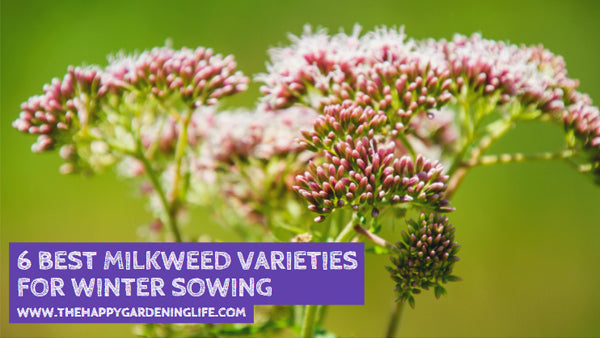
6 Best Milkweed Varieties For Winter Sowing
Share

If you're just starting out on your butterfly garden, planting milkweed varieties that are native to your region will deliver better results. Then as the native plants become more established, you can begin planting non-invasive types to further attract butterflies to your garden.
Best Milkweed Varieties To Winter Sow
We highly recommend these 6 native and perennial milkweed varieties to plant in your butterfly garden:
1. Swamp Milkweed (Asclepias incarnata)

The Swamp Milkweed is a herbaceous perennial that's native to North America. This variety is known for its long narrow leaves and clusters of fragrant soft mauve pink flowers. Easy to start from seed, the Swamp Milkweed likes moist soils with neutral to slight acidity, but it can also thrive in muddy clay soils. You can divide established plants in springtime and collect the seeds around October to November.
2. Purple Milkweed (Asclepias purpurascens)

Native to Eastern North America, the Purple Milkweed looks quite similar to the Common Milkweed except for its more pointed leaves and deep magenta flowers that bloom in late spring to early summer. Having the savanna as one of its native habitats, the Purple Milkweed is drought-tolerant and thrives in dry soil with good drainage. Growing this milkweed variety from seed is easy, and winter sowing is a good choice if you want more control over plant placement.
3. Common Milkweed (Asclepias syriaca)

Incredibly adaptable and simple to grow, the Common Milkweed is what most people think of when they hear word milkweed. Displaying light green leaves and large heads of pink-purple flowers, this species is amazing at attracting all sorts of insects, especially monarch butterflies. With the prairie as its natural habitat, the Common Milkweed thrives in full sun and rich loamy soil but can spread quite aggressively if left unmanaged. Removing the seed pods is ideal in order to control growth. Once established, the Common Milkweed is a haven for monarch butterflies, making it one of the best milkweed varieties for winter sowing.
4. Butterfly Weed (Asclepias tuberosa)

Known for its clusters of vibrant orange flowers, the Butterfly Weed is relatively easy to grow but takes time to establish. You'll have to wait around 2-3 years for the plant to produce flowers, but it's worth the wait as this variety can last for years. Some of the Butterfly Weed's native habitats are prairies, open woods and hillsides. It thrives in dry, well-drained soil and can tolerate drought. Many gardeners believe that Butterfly Weed and other milkweed species with long central taproots are difficult to transplant, but it can actually be done by following a few simple guidelines.
5. Whorled Milkweed (Asclepias verticillata)

Just like its name, the Whorled Milkweed is characterized by its skinny, whorled leaves. It has greenish-white flowers that bloom between July and September — a bit later in the season compared to other varieties, so it's ideal to have a different milkweed as the main host for caterpillars. The Whorled Milkweed thrives in open undisturbed areas and likes sand, clay or rocky soils in dry conditions. If not properly managed, the plant can spread aggressively. Known as one of the more toxic milkweed varieties, the Whorled Milkweed is often considered a weed in range areas because of its toxicity to livestock.
6. Prairie Milkweed (Asclepias sullivantii)

The Prairie Milkweed or Sullivant's Milkweed (named after the American botanist, William Starling Sullivant) is one of the most popular host plants for caterpillars. Shorter and less aggressive than the Common Milkweed, this particular species has fragrant pink flowers that bloom in summer, attracting several pollinators like monarch butterflies. Easily grown from seed and great for winter sowing, the Prairie Milkweed prefers moist soil conditions and will develop deep taproots after a couple of years — so it's important to plan the placement properly since transplanting can be tricky.
Conclusion
When deciding which milkweed to plant, pick those that are native to your region and make sure to meet their growing conditions. Also consider winter sowing milkweed so you can start seeds more effectively.
